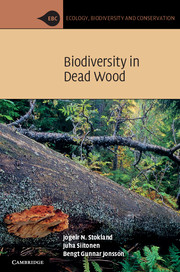Book contents
- Frontmatter
- Contents
- Preface
- 1 Introduction
- 2 Wood decomposition
- 3 The saproxylic food web
- 4 Other associations with dead woody material
- 5 Host-tree associations
- 6 Mortality factors and decay succession
- 7 Microhabitats
- 8 Tree size
- 9 The surrounding environment
- 10 Evolution of saproxylic organisms
- 11 Species diversity of saproxylic organisms
- 12 Natural forest dynamics
- 13 Dead wood and sustainable forest management
- 14 Population dynamics and evolutionary strategies
- 15 Threatened saproxylic species
- 16 Dead wood in agricultural and urban habitats
- 17 The value and future of saproxylic diversity
- References
- Index
6 - Mortality factors and decay succession
Published online by Cambridge University Press: 05 June 2012
- Frontmatter
- Contents
- Preface
- 1 Introduction
- 2 Wood decomposition
- 3 The saproxylic food web
- 4 Other associations with dead woody material
- 5 Host-tree associations
- 6 Mortality factors and decay succession
- 7 Microhabitats
- 8 Tree size
- 9 The surrounding environment
- 10 Evolution of saproxylic organisms
- 11 Species diversity of saproxylic organisms
- 12 Natural forest dynamics
- 13 Dead wood and sustainable forest management
- 14 Population dynamics and evolutionary strategies
- 15 Threatened saproxylic species
- 16 Dead wood in agricultural and urban habitats
- 17 The value and future of saproxylic diversity
- References
- Index
Summary
The way a tree dies has important effects on the species composition in decaying wood. It makes a great difference whether the tree dies suddenly, for instance because of a storm or a wildfire, or whether it dies gradually from competition, drought or old age. Different types of mortality produce dead trees with contrasting qualities, and therefore different species initiate the decomposition process. Later the decaying wood goes through major physical and chemical changes and the species composition changes completely several times until the wood is totally decomposed. The species themselves interact in many ways, and complete food webs build up and wane during the decomposition process. In combination, the different mortality factors and the decay succession have a great impact on the biodiversity in dead wood.
In addition to physically and chemically transforming the wood, the activity of wood decomposers also creates particular microhabitats such as sap exudations, insect galleries, space under loose bark, fungal fruiting bodies, rot holes and trunk cavities. Such microhabitats are important for a large number of species, and we describe them in detail in Chapter 7.
- Type
- Chapter
- Information
- Biodiversity in Dead Wood , pp. 110 - 149Publisher: Cambridge University PressPrint publication year: 2012
- 10
- Cited by



